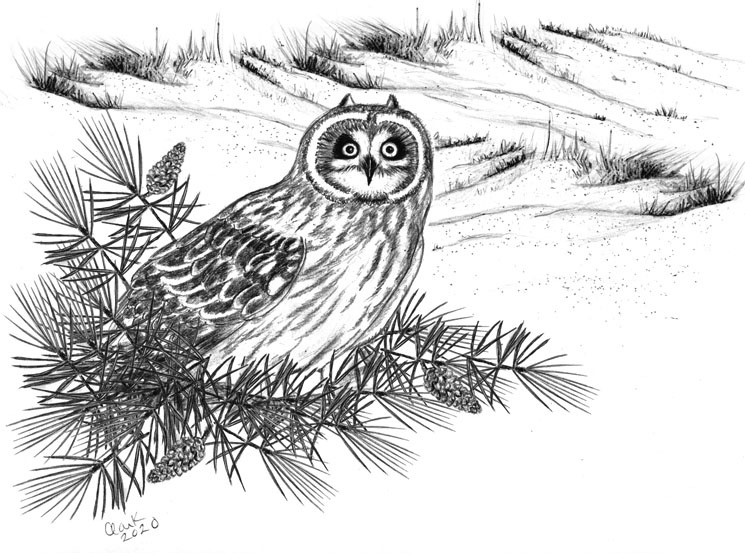
Dear Bird Folks,
Back in December, on WCAI’s Weekly Bird Report, they said it would be a bad winter for seeing Snowy Owls, but a good year for finding Short-eared Owls. I’ve never seen a Short-eared Owl before. Any suggestions where I should look?
– Debra, Yarmouth, MA
In a minute, Deb,
I’ll help you with your owl search in a minute, but first I want to shine a little light on WCAI’s Weekly Bird Report. I can’t believe I haven’t mentioned this report before. Maybe it’s because WCAI is in Woods Hole and who listens to Woods Hole radio stations? (It turns out a lot of folks do, including many of my customers.) The Weekly Bird Report is on every Wednesday morning at 8:45. The short segment is written and read by Mass Audubon’s super-smart and very entertaining Mark Faherty. Unfortunately, unless someone reminds me, I never remember to listen. Although unlike the old days when missing a show meant you missed it forever, we now can just punch up the station’s website and hear archived shows, which is what I often do…when someone reminds me.
As you mentioned, this has been a down year for Snowy Owls. Some people suggest that it hasn’t been cold enough for them to be here this winter, but it’s more complicated than that. Snowy Owl invasions appear to be tied to their breeding success. More baby snowys produced in the summer equates to more owls seen on Cape Cod in the winter. Mark Faherty acknowledged the lack of snowys, but also mentioned that this has been an exceptional year for Short-eared Owl sightings. But unlike Snowy Owls, which tend to remain in the same location for the winter (remember the West Dennis Beach owl?), Short-eared Owls have been far less stationary. So far, shortys have been seen in Falmouth, Brewster, Orleans and Eastham, but haven’t stayed in any one place for long. Are they simply working their way down Cape and will eventually settle in Provincetown? The answer to both of those questions is, yes.
Short-eared Owls are medium-sized birds. They are much smaller than Snowy or Great Horned Owls, but are considerably larger than the little screech-owls. Sometimes their “short ears” (which are tiny tufts of feathers) are visible, but often these tufts lie flat. It all depends upon the bird’s mood…or if it’s been wearing a hat. Back in the ‘70s, seeing a Short-eared Owl on the Cape, especially in the winter, was an annual event. Several pairs once nested on Monomoy Island and on nearby Nantucket. Since that time, things haven’t gone the owls’ way, and their population is in serious decline, which makes the recent sighting so exciting. Most owls are nocturnal hunters. Using the cover of darkness, they sit and wait for unsuspecting prey. Short-eared Owls do things differently. Instead of sitting and waiting, shorties are active foragers. They hunt by flying low over fields, bogs and dunes – harrier style. In addition, these owls often hunt before the sun goes down, allowing them to be seen by birders who are lucky enough to be looking in the right place. Speaking of that…
Last week I read a post by David Clapp. He reported seeing a Short-eared Owl hunting between the Provincetown Airport and the Race Point Beach parking lot. I don’t know who this David Clapp is, but I decided to check it out anyhow. Bird watching outings typically start early in the morning, but in this case, I waited for the end of the day when I thought the owl might be more active. We arrived in Provincetown at 3:45 and as soon as we passed the airport’s entrance, I saw the silhouette of a large bird flying behind one of the sand dunes. It could have been an owl, but it also could have been a gull or a crow, but this was a good place to start. I parked the car, grabbed my stuff and climbed to the top of the nearest dune. (Don’t tell the Park Service.) From here I could see the airport, the Atlantic Ocean and the splendor of the Province Lands. I was instantly reminded that we sure live in a beautiful place. But where was the owl this David Clapp guy had reported seeing? Oh, it was there.
As I stood on the dune, I could hear my wife coming up behind me. Without lowering my binoculars, I softly said, “Look at the top of the pitch pine on the next dune.” After a second of searching, she responded with an even softer, “Oh, my goodness.” There, sitting in the late afternoon sunlight, was the first Short-eared Owl I had seen in nearly thirty years. Wow! Most birds, for good reason, tend to avoid humans, but shortys are fairly tolerant of people. It just sat on the branch, looking around, totally uninterested in us, before it eventually headed off for the evening. Oh, my goodness, indeed. As we walked back to the car my wife wanted to talk about the owl, but there was something more important on my mind. I needed to point out that for the first time ever, I saw the bird before she did. It was a good day and there would be much gloating on the way home…for a change.
Short-eared Owls aren’t woodland birds, Debra. Like Snowy Owls, they are more often found in the open. The best places to look for them are dunes, fields, small airports and quiet beaches. You can see these owls at dawn, but they are also active at sunset, so sleep late if you want to. And who doesn’t want to? Also, thanks for mentioning WCAI’s Weekly Bird Report. I’ll be sure to listen next Wednesday morning at 8:45…if someone reminds me.